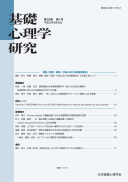Volume 14, Issue 2
Displaying 1-9 of 9 articles from this issue
- |<
- <
- 1
- >
- >|
-
Article type: Cover
1996Volume 14Issue 2 Pages Cover5-
Published: March 31, 1996
Released on J-STAGE: November 15, 2016
Download PDF (22K) -
Article type: Cover
1996Volume 14Issue 2 Pages Cover7-
Published: March 31, 1996
Released on J-STAGE: November 15, 2016
Download PDF (44K) -
Article type: Article
1996Volume 14Issue 2 Pages 67-73
Published: March 31, 1996
Released on J-STAGE: November 15, 2016
Download PDF (849K) -
Article type: Article
1996Volume 14Issue 2 Pages 75-85
Published: March 31, 1996
Released on J-STAGE: November 15, 2016
Download PDF (1249K) -
Article type: Article
1996Volume 14Issue 2 Pages 87-95
Published: March 31, 1996
Released on J-STAGE: November 15, 2016
Download PDF (1015K) -
Article type: Article
1996Volume 14Issue 2 Pages 97-105
Published: March 31, 1996
Released on J-STAGE: November 15, 2016
Download PDF (1052K) -
Article type: Article
1996Volume 14Issue 2 Pages 107-111
Published: March 31, 1996
Released on J-STAGE: November 15, 2016
Download PDF (573K) -
Article type: Article
1996Volume 14Issue 2 Pages 113-114
Published: March 31, 1996
Released on J-STAGE: November 15, 2016
Download PDF (333K) -
Article type: Article
1996Volume 14Issue 2 Pages 114-115
Published: March 31, 1996
Released on J-STAGE: November 15, 2016
Download PDF (332K)
- |<
- <
- 1
- >
- >|
